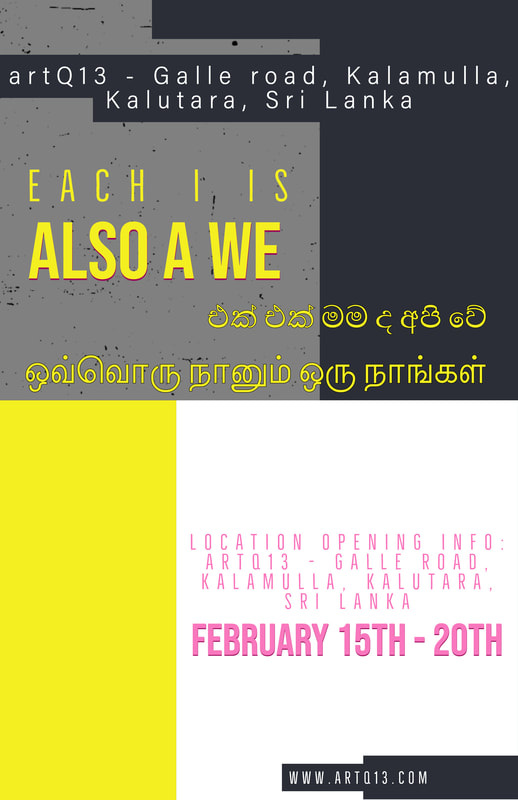Each I is also a We 2022
Each I is also a we trae ispirazione dalle strade di Kalamullain in Sri Lanka, dove tutti i segnali pubblici devono per legge essere riportati in singalese, tamil e inglese, per pensare il rapporto tra l’io e il noi e il loro mutuo costituirsi all’interno della relazione tra l’individuo e la sua comunità. Le identità contano per le persone, ogni identità dà un senso di appartenenza a livello sociale. Il noi fornisce all’io norme di comportamento che le persone seguono in ragione del loro essere parte di quel noi: la nazionalità, l’etnia, la religione o il genere che ci legano a determinati usi. In questo senso, ogni identità nell’affermare un io o un noi esclude ciò che è non-io e non-noi. L’identità nasconde in sé l’esclusione e genera spesso conflitto.
In Sri Lanka, infatti, dal 1983 al 2009 si è combattuta una sanguinosa guerra civile tra la minoranza Tamil e la maggioranza singalese che ha lasciato e continua a lasciare moltissime ferite. Dopo che il governo si è impegnato per la riconciliazione nazionale nel 2015 e ha dichiarato al Consiglio per i diritti umani che avrebbe attuato misure per venire a patti con la guerra civile, importanti passi, tra cui la riforma costituzionale, si sono bloccati. Il 27 febbraio 2020, al Consiglio dei diritti umani delle Nazioni Unite, il governo ha annunciato che non avrebbe continuato il processo di revisione richiesto in una risoluzione dalla comunità internazionale.
Da qui nasce l’idea di scrivere Each I is also a we nelle tre lingue per riflettere sul modo in cui le identità si essenzializzano nella convinzione di avere un sostrato di realtà o una natura autentica, dimenticando di essere in realtà il prodotto di una costruzione sociale che contribuisce alla formazione stessa dell’io e del noi, ma che non è in grado di ricomprenderli. L’essenzialismo, tuttavia, è una menzogna: non esiste alcuna essenza intrinseca dell’Io e del noi. Le persone cambiano costantemente nel corso delle relazioni con il noi e allo stesso modo, non c’è nulla che spieghi perché un cittadino dello Sri Lanka debba essere tamil o singalese. Un noi monoculturale, monoreligioso, monolinguistico non è mai esistito ed è una contraddizione in termini, così come l’idea che l’io nella sua identità sia sempre identico a sé stesso. L’io e il noi vengono reinventati costantemente. La dimenticanza di questo processo intersoggettivo costituisce un fattore essenziale nella creazione di un’identità conflittuale. Per questo motivo si è scelto di scrivere sulle lavagne con il gesso. Il tempo, infatti, cancella e fa cadere nell’oblio la frase scritta, così come il governo dello Sri Lanka vorrebbe occultare la memoria del paese.
L’opera fa parte del progetto del progetto Other Rooms, Other Thoughts che vede coinvolte diverse città (Kalamulla/Sri Lanka, Parigi/Francia, Bucarest /Romania, Kharhiv/Ucraina) con l’intento di incontrare nella vita quotidiana la sfaccettata realtà delle nostre differenze, quel luogo di incontro tra l’io e il noi che ci rende co-individui.
Each I is also a we trae ispirazione dalle strade di Kalamullain in Sri Lanka, dove tutti i segnali pubblici devono per legge essere riportati in singalese, tamil e inglese, per pensare il rapporto tra l’io e il noi e il loro mutuo costituirsi all’interno della relazione tra l’individuo e la sua comunità. Le identità contano per le persone, ogni identità dà un senso di appartenenza a livello sociale. Il noi fornisce all’io norme di comportamento che le persone seguono in ragione del loro essere parte di quel noi: la nazionalità, l’etnia, la religione o il genere che ci legano a determinati usi. In questo senso, ogni identità nell’affermare un io o un noi esclude ciò che è non-io e non-noi. L’identità nasconde in sé l’esclusione e genera spesso conflitto.
In Sri Lanka, infatti, dal 1983 al 2009 si è combattuta una sanguinosa guerra civile tra la minoranza Tamil e la maggioranza singalese che ha lasciato e continua a lasciare moltissime ferite. Dopo che il governo si è impegnato per la riconciliazione nazionale nel 2015 e ha dichiarato al Consiglio per i diritti umani che avrebbe attuato misure per venire a patti con la guerra civile, importanti passi, tra cui la riforma costituzionale, si sono bloccati. Il 27 febbraio 2020, al Consiglio dei diritti umani delle Nazioni Unite, il governo ha annunciato che non avrebbe continuato il processo di revisione richiesto in una risoluzione dalla comunità internazionale.
Da qui nasce l’idea di scrivere Each I is also a we nelle tre lingue per riflettere sul modo in cui le identità si essenzializzano nella convinzione di avere un sostrato di realtà o una natura autentica, dimenticando di essere in realtà il prodotto di una costruzione sociale che contribuisce alla formazione stessa dell’io e del noi, ma che non è in grado di ricomprenderli. L’essenzialismo, tuttavia, è una menzogna: non esiste alcuna essenza intrinseca dell’Io e del noi. Le persone cambiano costantemente nel corso delle relazioni con il noi e allo stesso modo, non c’è nulla che spieghi perché un cittadino dello Sri Lanka debba essere tamil o singalese. Un noi monoculturale, monoreligioso, monolinguistico non è mai esistito ed è una contraddizione in termini, così come l’idea che l’io nella sua identità sia sempre identico a sé stesso. L’io e il noi vengono reinventati costantemente. La dimenticanza di questo processo intersoggettivo costituisce un fattore essenziale nella creazione di un’identità conflittuale. Per questo motivo si è scelto di scrivere sulle lavagne con il gesso. Il tempo, infatti, cancella e fa cadere nell’oblio la frase scritta, così come il governo dello Sri Lanka vorrebbe occultare la memoria del paese.
L’opera fa parte del progetto del progetto Other Rooms, Other Thoughts che vede coinvolte diverse città (Kalamulla/Sri Lanka, Parigi/Francia, Bucarest /Romania, Kharhiv/Ucraina) con l’intento di incontrare nella vita quotidiana la sfaccettata realtà delle nostre differenze, quel luogo di incontro tra l’io e il noi che ci rende co-individui.
Each I is also a We 2022
Each I is also a We takes its inspiration from the streets of Kalamullain in Sri Lanka — where all public signs are required by law to be in Sinhalese, Tamil and English — to consider the relationship between the ‘I and the we’ and their mutual role in the relationship between the individual and their community. Identities matter to people; each identity gives a sense of belonging on a social level. The ‘we’ provides the ‘I' with norms of behaviour that people follow because of their pertaining to that ‘we’: the nationality, ethnicity, religion or gender that bind us to certain customs. In this sense, any identity in affirming an 'I' or 'we' excludes that which is ‘not-I’ and ‘not-we’. Identity conceals exclusion and often generates conflict.
Indeed, in Sri Lanka, a bloody civil war between the Tamil minority and the Sinhalese majority was fought from 1983 to 2009, which left and continues to leave many scars. After the government committed to national reconciliation in 2015 and declared to the Human Rights Council that it would implement measures to reach an agreement regarding the civil war, important progress —including constitutional reform — has stalled. On 27 February 2020, at the UN Human Rights Council, the government announced that it would not continue the review process called for in a resolution by the international community.
This gave rise to the idea of writing Each I is also a We in the three aforementioned languages, in order to reflect on the way in which identities are essentialised in the belief that they have a substratum of reality or an authentic nature, forgetting that they are in fact the product of a social construction which contributes to the very formation of the ‘I’ and the ‘we', but which is not capable of encompassing them. Essentialism, however, is a falsehood: there is no intrinsic essence of the 'I' and 'we'. People are constantly changing in the course of their relations with the ‘we’, and similarly, there is nothing to explain why a Sri Lankan should be Tamil or Sinhalese. A mono-cultural, mono-religious, monolingual ‘we’ has never existed and is a contradiction in terms, as is the idea that the ‘I' is always identical to itself in its identity. The ‘I’ and the ‘we’ are constantly being reinvented. Forgetting this intersubjective process is an essential factor in the creation of a conflicting identity. This is why the blackboards are written on in chalk: time erases the sentence, causing it to fall into oblivion, just as the Sri Lankan government hopes to conceal the country's memory.
The work is part of the Other Rooms, Other Thoughts project involving several cities (Kalamulla/Sri Lanka, Paris/France, Bucharest/Romania, Kharhiv/Ukraine) with the aim of encountering in everyday life the multifaceted reality of our differences; that meeting place between the ‘I' and the ‘we’, which makes us co-individuals.
Each I is also a We takes its inspiration from the streets of Kalamullain in Sri Lanka — where all public signs are required by law to be in Sinhalese, Tamil and English — to consider the relationship between the ‘I and the we’ and their mutual role in the relationship between the individual and their community. Identities matter to people; each identity gives a sense of belonging on a social level. The ‘we’ provides the ‘I' with norms of behaviour that people follow because of their pertaining to that ‘we’: the nationality, ethnicity, religion or gender that bind us to certain customs. In this sense, any identity in affirming an 'I' or 'we' excludes that which is ‘not-I’ and ‘not-we’. Identity conceals exclusion and often generates conflict.
Indeed, in Sri Lanka, a bloody civil war between the Tamil minority and the Sinhalese majority was fought from 1983 to 2009, which left and continues to leave many scars. After the government committed to national reconciliation in 2015 and declared to the Human Rights Council that it would implement measures to reach an agreement regarding the civil war, important progress —including constitutional reform — has stalled. On 27 February 2020, at the UN Human Rights Council, the government announced that it would not continue the review process called for in a resolution by the international community.
This gave rise to the idea of writing Each I is also a We in the three aforementioned languages, in order to reflect on the way in which identities are essentialised in the belief that they have a substratum of reality or an authentic nature, forgetting that they are in fact the product of a social construction which contributes to the very formation of the ‘I’ and the ‘we', but which is not capable of encompassing them. Essentialism, however, is a falsehood: there is no intrinsic essence of the 'I' and 'we'. People are constantly changing in the course of their relations with the ‘we’, and similarly, there is nothing to explain why a Sri Lankan should be Tamil or Sinhalese. A mono-cultural, mono-religious, monolingual ‘we’ has never existed and is a contradiction in terms, as is the idea that the ‘I' is always identical to itself in its identity. The ‘I’ and the ‘we’ are constantly being reinvented. Forgetting this intersubjective process is an essential factor in the creation of a conflicting identity. This is why the blackboards are written on in chalk: time erases the sentence, causing it to fall into oblivion, just as the Sri Lankan government hopes to conceal the country's memory.
The work is part of the Other Rooms, Other Thoughts project involving several cities (Kalamulla/Sri Lanka, Paris/France, Bucharest/Romania, Kharhiv/Ukraine) with the aim of encountering in everyday life the multifaceted reality of our differences; that meeting place between the ‘I' and the ‘we’, which makes us co-individuals.

